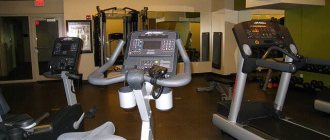This article was prepared by our beloved partners - the #GMfood - an online store of superfoods and craft eco-products.
Just for registering in the store you will receive 300 rubles to your personal bonus account and 2 more interesting gifts (Grab your gifts here)In the store's assortment you will find not only superfoods, but also healthy sweets, breakfasts, herbal teas, peanut butter, master classes for body health and facial beauty, and this is only a small part of the goodies and benefits!
Subscribe to Instagram #GMfood using this link and regularly receive new PP recipes with superfoods, see useful guides to the world of proper nutrition, and also look for gifts hidden under the link in the profile!
The benefits of walking for weight loss
Daily walking in the fresh air has a positive effect on health.
Walking helps:
- Improving heart function and strengthening the heart muscle;
- Ensuring active lung function;
- Positively affects the condition of the muscles;
- Stimulates blood flow in the legs, prevents the occurrence of varicose veins;
- Helps get rid of fat deposits. Walking at an average pace for 20 - 30 minutes helps burn up to hundreds of kilocalories;
- Helps maintain reproductive health;
- Effective in the fight against osteochondrosis, nourishes bone tissue, normalizes the processes of its formation;
- Regular walks help strengthen the immune system and improve the quality of sleep;
- Positively affects the nervous system and brain function.
Regular walking in the fresh air, even for 15 minutes a day, leads to the release of happiness hormones into the blood - endorphins, serotonin, dopamine, oxytocin, which helps to resist stressful situations.
They are actively synthesized in those moments when the brain identifies positive moments.
Each of them is associated with positive emotions. Dopamine creates a feeling of joy when a person finds what he wanted to find. Endorphin creates a feeling of oblivion that helps alleviate pain. Oxytocin gives a feeling of comfort in society. Serotonin creates a sense of social importance in a person.
Serotonin is one of the main neurotransmitters. It is often called the “happiness hormone” and the “good mood hormone.”
Source Wikipedia
Make a Buddy
If you're giving up on digital motivation, try replacing it with a gym buddy. It's the social support and positive feedback that helps create long-lasting behavior changes, rather than just recording data like a fitness tracker would.
Researchers from the University of Aberdeen found that support from gym friends increased the amount of exercise participants did.
Find a walking group to encourage each other to increase the number of steps you take. Set new goals for yourself, exchange photos. Creating your own community of like-minded people will be beneficial on many levels.
Found a violation? Report content
How long should you walk a day to lose weight?
The number of kilograms lost depends on the individual characteristics of each person’s body. Timing is of no small importance: it is better to walk at the same time. The body gets used to this daily routine and metabolism is activated during this period.
Anyone can do walking - pensioners, people with excess body weight. The walk can last an unlimited amount of time and you can walk as far as a person can handle it. You need to start with small distances, constantly increasing them, and also increasing the pace of movements.
A person will feel the need to increase the duration and intensity of walking himself. This will be evidenced by easy tolerance to stress and the desire to move on.
Walking should become a part of life. To burn more calories, you need to walk more - to and from work, to the store, for a walk, to the cinema, to entertainment events.
For an untrained person, it is enough to move at a speed of 3–4 kilometers per hour. More trained people can move at a speed of 6 - 8 km per hour.
physical activity should be stopped if shortness of breath, rapid heartbeat, or pain in the heart occurs.
To start the process of burning fat, you need to walk for at least an hour a day and take 10 thousand steps, which equals approximately 6 - 7 km.
Sample walking program for weight loss
The weight loss program and intensity of exercise should be developed individually for each person in accordance with the body’s reaction.
1 Week
Monday
Slow walking for 30 – 40 minutes. The day is a preparatory day and based on its results, a conclusion is drawn on how to train further.
Tuesday
Slow walking for one hour.
Wednesday
Slow walking from 1 to 1.5 hours.
Thursday
Walk at a moderate pace for about half an hour. You can increase the load.
Friday
Moderate walking pace for an hour to an hour and a half. You can take a rest break.
Saturday
Walking at a moderate pace for 1.5 – 2 hours. Maybe take a break.
Sunday
Walk at a slow pace.
2 week
Monday
Walk at a moderate pace for at least an hour. Doing breathing exercises.
Tuesday
Interval walking with breathing exercises.
Wednesday
Walk with jumps and squats.
Thursday
Walk with a fast pace of walking and breathing exercises.
Friday
Walk at a moderate pace with free exercise.
Saturday
Brisk walking and light exercise.
Sunday
Walk at a moderate pace.
3 week
Monday
Strength training.
Tuesday
Walk briskly for half an hour with light exercise.
Wednesday
Walking at a moderate pace, strength exercises and breathing exercises.
Thursday
Fast walking with breathing exercises.
Friday
Interval walking with strength exercises for 15 minutes.
Saturday
Fast walking, free exercise.
Sunday
Walk at a moderate pace.
4 week
Monday
Walking with strength and breathing exercises.
Tuesday
Fast walking with floor exercises.
Wednesday
Interval walking with strength exercises for half an hour.
Thursday
Interval walking with free exercise or breathing exercises.
Friday
Fast walking with strength exercises.
Saturday
Interval walking with free exercises.
Interval walking involves changing from a moderate pace to a fast one and can increase calorie burning by up to 15%.
Sunday
Slow walking.
Add body exercises to your walk
Incorporating simple bodyweight exercises into your walk will help you achieve your weight loss goals in two ways:
A student at the Vietnam Police Academy shared how she takes care of her facial skin.
Smooth and fresh skin: dermaplaning, or why a woman needs to shave her face
A Brazilian travels 36 km by bike every day to take his loved one home.
- firstly, you will burn more calories while walking;
- Secondly, it helps increase your metabolic rate so that you burn more calories at rest.
Add compound movements (those that work multiple muscle groups) to get the maximum calorie burn for your efforts. Walking lunges can be easily integrated into even short walks. They will work the entire lower body. The same applies to push-ups from a wall or bench. Combine all three exercises (walking, lunges, push-ups) and you will work the muscles of your entire body from head to toe, without even breaking a sweat!
When is the best time to go
Choose the time of your walks at your own discretion, when it is convenient for you, taking into account your working hours. Walking in the morning helps burn calories quickly. But before the walk you need to have breakfast, otherwise the functioning of the gastrointestinal tract may be disrupted.
Evening walks help get rid of negative emotions accumulated during the day and improve sleep. You need to go for a walk no later than 3 hours before bedtime so that your biological rhythms do not go astray.
You should not walk in the heat, as such walks lead to fluid loss and can lead to overheating.
How to walk correctly to lose weight
To lose weight 100%, you need to follow some tips:
- The duration of the walk should be at least one hour, because... the fat burning process begins approximately 45 minutes after continuous walking;
- It is better to go in the morning after a light breakfast. This speeds up metabolism and more calories are burned. Morning walks help burn fat faster;
- Clothes should be loose, the soles of sneakers should have good shock absorption;
- To make walking as useful as possible, you need to choose a route over rough terrain, with ups and downs;
- Before walking, be sure to warm up, especially if it is interval walking. You need to start training with warm-up exercises, familiar to everyone from school. After completing your workout, walk slowly for 5 minutes to calm your heart rate.
During any physical exercise, the body loses a lot of fluid, so before and after training you should drink a glass of water to avoid dehydration.
You need to understand that in order to lose weight, you need to exercise regularly. One-time training will not bring results. If you walk every day and eat right, you can lose 6–8 kg per month.
Walking is a solution to problems for many. There is no need to go to the gym, buy special equipment or sportswear. All you have to do is move more.
Possible restrictions and contraindications
For walking, you need to choose quality shoes. It is also important to develop your walking pace gradually and carefully monitor your breathing, because incorrect inhalation and exhalation can cause more harm than good.
Note! Walking too fast can harm your knee joints, so if you experience discomfort in your knees, you should consult your doctor about the possibility of further training and their correction.
The main contraindications are:
- The presence of recent operations.
- Infectious diseases.
- The presence of chronic diseases occurring in acute form.
- High blood pressure or heart disease.
- Injuries to legs and arms.
- A person has flat feet.
- Musculoskeletal disorders.
How does walking affect weight loss?
An average person has to walk from one to 10 kilometers during the day. Without noticing it, we burn calories when walking. The more we walk, the more we burn. Therefore, in a month, without noticing it, you can lose 2–3 kilograms with the help of walking.
But walking is different, and, therefore, calorie consumption will also be different. If a person walks at a slow pace, then fewer calories are consumed than if he walks at a fast pace. The number of calories increases when climbing stairs, mountains or walking over rough terrain.
If you walk for 2 hours every day, you can burn up to 2000 kcal in a week, which is approximately 200 g of subcutaneous fat. But this is provided that you lead a healthy lifestyle, eat right, and do not overeat.
Many factors influence weight loss while walking:
- Age;
- Weight;
- Walking speed;
- Duration and regularity of walks.
On average, walking quickly for an hour consumes 200–300 kcal. If your weight is 60 kg, then walking at a speed of 4 km/hour burns 200 kcal in an hour. When walking 6 km/hour – 315 kcal. When climbing stairs up, 5 kcal are spent, and when going down – 3 kcal per minute.
To calculate your speed, count the number of steps. 50 steps per minute is approximately 3 km/h, 75 is 4.5, 100 is 6 km/h.
To lose weight, you need to walk every day in any weather. The walking speed should not be too high so as not to get tired, but not too slow, otherwise there will be no result from walking.
Change the angle of the road
About 30% more calories are burned if you walk on an upward path. This way you'll use more energy going uphill, but a third is a nice bonus. If you climb uphill, you'll be working your hamstrings (back of your thighs) and glutes (back muscles).
Taking short steps helps reduce the stress on your joints when climbing up and will also help you maintain your balance. You may lean forward a little as you climb a hill - this is a natural process and is normal, but always try to keep your body over your hips.
Lost weight: what Sofia Tarasova sacrificed for the sake of “VIA Gra” (new photos)
It’s good to wash often: myths about shampoo and hair care that only harm
"Dad is offended." Agata Muceniece about her relationship with Priluchny after the divorce
Are there any hills nearby? Use a treadmill! Set the incline to 3-5° and maintain a good pace.











